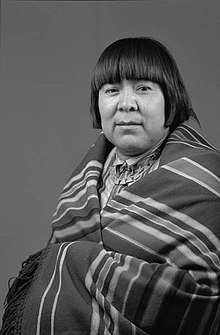Joe Herrera
Joe Hilario Herrera (born 1923 in Cochiti - 2001), also known as See Ru, was a Pueblo painter from a mixed Cochiti and San Ildefonso background.[1] He was the son of the artist Tonita Peña and trained at the Santa Fe Indian School.[2]
Early life and education

Herrera inherited rich artistic traditions from both of his parents. His father was from Cochiti, where he grew up, while his mother was from San Ildefonso. Through his mother, he was also related to the famed potter Maria Martinez. His early interest in painting was stimulated by watching her husband Julian Martinez paint, but above all through the strong influence of his mother, who was the most prominent Native American female painter of her generation. Herrera swatted flies away from his mother's paint dishes while she worked, and in return she gave him paint with which he began to experiment at the age of five.[2]
Like many other Native artists from the Southwest at the time, Herrera trained at the Studio School which had been founded by Dorothy Dunn, but was by this time directed by the San Juan Pueblo artist Geronima Montoya. His early art was in the flat watercolour style typical of the School's output.[2] In his youth, he also served in the US Army during World War II and worked at the Laboratory of Anthropology before completing a degree in art education at the University of New Mexico.[1]
Artwork
Influenced by his mother's style and by the style of the Studio School, Herrera initially produced paintings of Pueblo dancers in flat, opaque watercolours.[1][2] Like many other artists from the School, including his mother, Herrera worked painting murals, which was a popular form of patronage for Native art in the 1930s and 1940s.[2][3] However, he was one of the first Studio School-trained Native American artists to move away from representational art into more abstract expression.[3] The artist Raymond Johnson was an influential figure in this shift after Herrera studied under him at the University of New Mexico between 1950 and 1953.[4][2] Of his own work, Herrera said:
Klee sought to see the wonders of nature thorugh the eyes of aborigines and children, and attempted to combine their freshness of vision with his own cultivated knowledge, [while] I attempted the reverse, bringing the innovations and intellectual constructs of modern art to bear on traditional Pueblo imagery.
— Joe Herrera, unpublished interview, on file at the Native American Artists Resource Collection, The Heard Museum, Phoenix, AZ (see Berlo and Phillips, p. 223)
Herrera's work has been described as "coolly decorative", in contrast with his mother's "warmly natural" art.[1] His synthesis of traditional Pueblo art, Studio School training, and engagement with modernism and abstract styles was influential on an entire generation of artists.[4]
His art was featured alongside his mother's in the 2018 exhibition "Generations in Modern Pueblo Painting: The Art of Tonita Peña and Joe Herrera" at the Fred Jones Jr. Museum of Art at the University of Oklahoma. The exhibit highlighted the seminal influence both artists had on subsequent generations of painters and how both mother and son forged new paths which grew out of but also broke from tradition. It was the first significant exhibition of Peña's work since the 1930s, and the premiere of many of Herrera's later works. Curator W. Jackson Rushing III said of the exhibition, "It is my contention that Peña and Herrera were key figures in the development of modern art in the United States and that there is no satisfying explanation for their exclusion from surveys on the subject. On the contrary, for several reasons, a critical examination of their aesthetic achievements and legacy reshapes our understanding of American modernism."[5]
See also
References
- "Joe Herrera Paintings - Adobe Gallery, Santa Fe". www.adobegallery.com. Retrieved 2019-06-01.
- Berlo, Janet C.; Phillips, Ruth B. (1998). Native North American Art. Oxford: Oxford University Press. pp. 219–223.
- "Fine Art | Native American Paintings | Native American Artwork | Cochiti Pueblo | Joe Herrera | Original Painting of a Ram Dancer - Adobe Gallery, Santa Fe". www.adobegallery.com. Retrieved 2019-06-01.
- "Native American: A668 Joe Herrera". www.bischoffsgallery.com. Retrieved 2019-06-01.
- "'Generations in Modern Pueblo Painting' showcases art by mother and son Tonita Peña and Joe Herrera at Fred Jones Jr. Museum of Art". Oklahoman.com. 2018-01-22. Retrieved 2019-06-01.